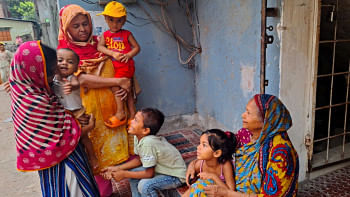Bold, pragmatic measures can revitalise Bangladesh’s health sector

Bangladesh, with a population of over 17 crore, is the eighth most populous country in the world. With the annual population growth rate of around one percent, it is likely to stabilise at around 240-250 million, posing considerable challenges for Bangladesh given its small land area and other resource constraints.
From high fertility (TFR of over six) until the mid-1980s, fertility declined to 3.3 during 1994-2000, and further to 2.3 by 2011. However, it has stalled at that level since then. The family planning programme achieved commendable success until 2011, with the contraceptive prevalence rate (CPR) rising from around four percent in the 1960s to 61.2 percent in 2011, but it has remained almost unchanged (64 percent in 2022, according to Bangladesh Demographic and Health Survey) since then. This is on account of several factors, including, but not limited to: i) decline in the relative share of longer-acting and permanent methods (LAPM), from 32 percent of modern method use in 1994 to only 14 percent in 2022; relying on temporary methods rather than accepting LAPM by women who have completed their family size poses a major problem for the efficiency of the programme; ii) Relatively high unmet need for contraception (10 percent); if users of traditional methods (nine percent) are considered, the total unmet need for modern methods was 19 percent in 2022; iii) relatively high discontinuation, implying huge system loss for the programme (around half of the users stop using a method within 12 months of starting its use; and iv) erratic interruptions in supplies of contraceptives.
Since independence, Bangladesh has achieved considerable success in most health indicators, though there are inequities based on the socioeconomic status of the population. The infant mortality rate (IMR) declined from 144 deaths per 1,000 live births in 1971 to 25 in 2022, though it is higher than in Sri Lanka, Nepal, Maldives and Bhutan. The under-five mortality rate declined from 223 to 31, but it is higher than in Sri Lanka and Maldives. The maternal mortality ratio (MMR) declined from 574 deaths per 100,000 live births in 1990 to 176 in 2017, but it is higher than the average MMR in South Asia (157 in 2017), and also higher than in India, Sri Lanka, Bhutan and Maldives. Over the past five decades, there has been a rise in life expectancy from 45 years to around 74 years, but it is lower than in Sri Lanka and Maldives.
Between 1990 and 2019, the total number of people with non-communicable diseases (NCDs) increased from 9.55 crore to 14.5 crore. Deaths due to NCDs increased, with 14 of the top 20 leading causes of death in 2019 due to such diseases, with stroke at the lead. If this trend continues, management of the increased burden of NCDs will be a considerable challenge for the country's healthcare system. Cost-effective, multisectoral efforts are needed to prevent and control NCDs, promote healthy lifestyle, and prevent premature mortality and disabilities. There has been a substantial decline in deaths due to communicable diseases—malaria, dengue, AIDS, tuberculosis and diarrhoea—though they still remain significant causes of illness and premature deaths. Bangladesh is also a high-risk country for emerging communicable diseases as a result of its high population density and poverty.
Although there has been considerable decline in child and maternal malnutrition, it continues to be a serious public health problem in the country. Also, there are sharp differences in child malnutrition based on mothers' education and household income.
Women of reproductive ages are vulnerable to chronic energy deficiency and malnutrition, the major risk factors for adverse birth outcomes. The double burden of malnutrition is becoming more prevalent among Bangladeshi women. Those with uneducated husbands, those with little or no education, and those belonging to less well-off households, especially from rural areas, are more likely to be underweight than women in other groups, while overweight is higher among the educated and those belonging to relatively well-off households. High rates of maternal malnutrition and low birth weight (LBW) can lead to a high burden of NCDs in adult life. The prevalence of LBW in Bangladesh is around 16 percent, similar to that in India and Pakistan, but higher than in Nepal and Sri Lanka. LBW is inversely associated with mothers' education, household income, and occupation.
In addition to problems specific to population, health and nutrition, there are several constraints that cut across all three of these sub-sectors. Quite importantly, there is an apparent lack of political commitment, affecting the overall healthcare sector. This is clearly evident from i) low investment in the health sector (less than one percent of GDP), the lowest in South Asia; ii) high out-of-pocket (OOP) expenses—about 70 percent—the ever-rising cost of healthcare making quality healthcare services virtually out of reach, especially among the poor; iii) both the health and population policies of 2012 not updated for 12 years; iv) human resource problems—inadequate staffing, lack of trained staff, absenteeism at different levels, one of the worst nurse-physician ratios in the world; v) lack of coordination among various actors and stakeholders, resulting in duplication, inefficiency, wastage, and gaps in service delivery; vi) bifurcation of the Ministry of Health and Family Welfare into two divisions, thereby further hampering coordinated service delivery from the Directorate General of Family Planning (DGFP) and Directorate General of Health Services (DGHS); vii) lack of effective coordination between the health ministry and the Ministry of Local Government, Rural Development and Cooperatives, thereby adversely affecting urban healthcare delivery services; viii) lack of effective monitoring and supervision; and ix) lack of transparency and accountability at different levels of the programme.
Bold and pragmatic reform measures should be undertaken to revitalise the entire health sector to overcome the constraints identified above in order to improve access, quality, and sustainability of healthcare services to people, with special consideration given to the poor and the needy. Investment in the health sector must unquestionably be enhanced to around two percent of GDP, together with enhanced spending capacity of the programme with the objective of major overhauling of the sector, wherever needed, such as in human resource-related issues, procurement, and helping reduce OOP. Likewise, allocation to the education sector should be enhanced to raise not only enrolments but also—and more importantly—to improve quality of education at different levels, with special consideration given to female education. The latter will help reduce child marriage and raise child-bearing age as well as female employment.
The outdated health and population policies should be updated, taking into consideration both demographic and epidemiological changes as well as socioeconomic changes that have occurred during this period. Pragmatic mechanisms should be put in place to ensure effective monitoring and supervision, meaningful coordination among all actors and stakeholders in the programme, including between the health and local government ministries, and address issues related to the lack of accountability and transparency at different levels of the programme. To give further impetus to political commitment, a high-level body—a national health council—should be formed under the leadership of the head of the government, to review progress and constraints, and provide oversight to programme activities, at least biannually. The council should include concerned stakeholders, including high-level professionals from relevant disciplines.
Barkat-e-Khuda, PhD, is a former professor and chairman of the Department of Economics at Dhaka University. He can be reached at [email protected].
Views expressed in this article are the author's own.
Follow The Daily Star Opinion on Facebook for the latest opinions, commentaries and analyses by experts and professionals. To contribute your article or letter to The Daily Star Opinion, see our guidelines for submission.

 For all latest news, follow The Daily Star's Google News channel.
For all latest news, follow The Daily Star's Google News channel. 












Comments